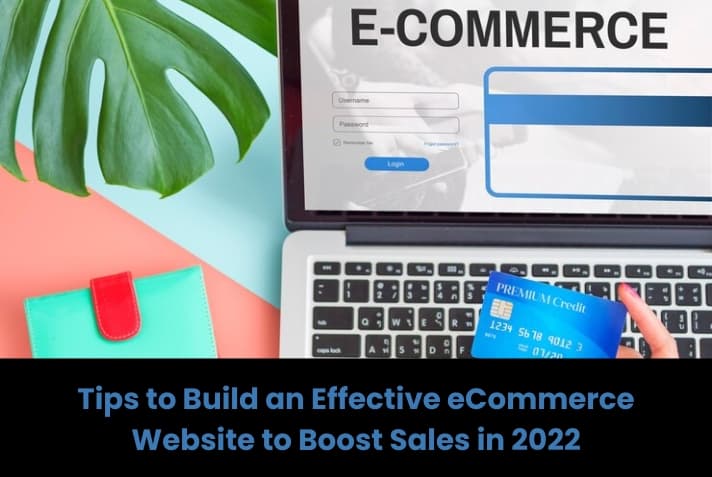Tips to Build an Effective eCommerce Website to Boost Sales in 2022

One of the most common concerns among merchants is the construction of an e-commerce website. Your e-commerce website, like the retailers in malls, should make a good first impression. Visitors to your website will be enticed to browse and buy if you have an attractive window display and well-organized merchandise. Your online store will lose sales due to poor e-commerce website construction.
What is required to build a beautiful and high performing ecommerce website?
An e-commerce website differs from other websites in several ways. Payment choices, site architecture, design, page load speed, and photography, to mention a few, are among the other elements. You'll need a platform that can handle enough server resources. Otherwise, your store may experience substantial slowdown or even crash.
What makes an effective ecommerce website?
An e-commerce site allows you to create a brand that customers will want to shop from again and again. It allows you to connect with and increase your clients while selling your products and services. It is critical for an E-commerce website to have the correct website design in order for it to effectively fulfil its job, which is to bring in more paying customers.
With 2020 being a watershed moment for E-commerce platforms, it's critical for present and future E-commerce platforms to understand how design influences sales.
To help you keep on top of the current web design trends for e-commerce websites in 2022, we've compiled a list of e-commerce website design tips that will make creating an e-commerce store a breeze.
What top 8 features are a must for any ecommerce site?
E-commerce websites should be simple to use.
On the walk to the check-out cart, talk about getting lost. Many e-commerce websites are guilty of having an excessive amount of content. A messy website causes visitors to become perplexed. Customers frequently abandon their carts and go to your competitor's website when information is confusing.
The navigation on an e-commerce website, as well as the path to check out, should be exceedingly straightforward and require the fewest steps necessary.
E-commerce sites must develop a strong brand identity.
Branding is one factor that can make or ruin your E-commerce store. People want to be connected with a certain brand. It sets you apart from your competitors.
When creating a website, you should spend as much time as possible identifying your brand. Incorporate your brand into all aspects of your website.
There are thousands of fake E-commerce sites on the internet, and brands are the only way to tell which ones are legitimate. On an e-commerce site, branding helps to generate trust and boost purchases.
The content of your website, such as photos and writing, should build the brand's identity. Everything on the website, from logos to online copy, should be professional and error-free.
Visitors should be considered when designing e-commerce sites.
Your E-commerce site should attempt to educate the customer and create a sale, from the design, look, and feel, through the ultimate experience.
When creating websites for E-commerce platforms, it's critical to include pages and features that reflect the buyer's journey. Allow for a quick and painless purchasing experience. Customers will return to a site if the checkout procedure is simple.
Consider it this way: You're a web surfer wanting to order cat chow from the comfort of your own home. What is the first thing you type in? Aren't they the necessary keywords?
What else are you on the lookout for?
- A good representation of the product
- Its in-depth description
- supplementary information
- Modes of checkout and payment
- Confirmation of your order One of the most important things in making an e-commerce website successful is having appropriate product pages.
Colors that are related to the items or services on an e-commerce site should be used.
Customers are impacted by the colours they see when making purchasing decisions, according to buyer psychology. Colors are significant in physical businesses as well as on e-commerce sites. To increase sales, E-commerce websites should utilise positive affirmative colours that represent trust.
Most E-commerce websites go toward the colour white as a general rule to highlight the products rather than the website. The colour blue is commonly used to promote confidence on service-based websites. The colour red, which represents hunger, is used on food and shopping websites.
Make the decider buttons, also known as call-to-action buttons, stand out by using a different colour. These buttons must stand out from the rest of the web page elements in order for conversions (sales) to occur.
Content on e-commerce sites should be concise and photos should be of high quality.
Sales are directly influenced by images. People who shop on e-commerce platforms are unable to touch and feel the merchandise. The sole factor influencing whether or not to purchase a product is its image/video.
High-quality photography should be used across the site, not just in product images. Headers, banners, footers, and randomly placed adverts should all have high-quality imagery to show credibility. Put up quality photographs of your products for sale, taken from numerous perspectives, to assist users decide quickly.
You can also make your social content shoppable by employing a visual commerce platform to tag products in your visual content and integrating these shoppable galleries on your eCommerce website, which will directly improve your sales.
In addition to photographs, the online writing and other information on the site must be excellent. The majority of text material is ignored, however there are a few keywords and modifiers that will be noted.
Customers visit an e-commerce site for the visuals, not for the verbose copy. As a result, the text should contain as few words as possible to convey the brand message.
Also, don't forget to include testimonials; they'll help you boost both trust and conversions. Aim for a higher percentage of 4 and 5-star ratings and reviews.
To render across all platforms, e-commerce businesses should adopt responsive website design.
A mobile and smartphone-obsessed generation requires shopping websites that work equally effectively on mobile devices as they do on desktop computers.
Making your e-commerce site operate requires proper rendering on mobile devices, as well as a rapid responsive design and usable buttons.
Mobile visitors are responsible for 54% of total E-commerce sales. If you want to do more business, you need to use responsive design.
E-commerce sites should have a well-organized site architecture that includes classification.
An E-commerce website can feature anywhere from one to a thousand things for sale. On a large website, accurate product categorization is critical.
Users find it easier to identify the product they came seeking for by utilising relevant filters or categorising products in a pre-defined Menu, which leads to a sale.
If product categories aren't created, things are dispersed around the store, making it harder for customers to find what they're looking for. It's like a department store: the cash registers keep ringing as long as everything is perfectly organised.
E-commerce websites must be safe.
Customers trust only trustworthy websites that offer secure transactions when shopping online. To have an efficient E-commerce web design, you must have an SSL encrypted site with secure payment gateways.
How do I make my ecommerce website design successful?
Website design is simple, but creating E-commerce website design that convert is difficult. Designing an e-commerce website becomes easier with the above-mentioned E-Commerce website design tips and some assistance from a reputable ecommerce website development company in India like indianwebsitecompany.com.
Indian Website Company is a leading website design company in India and has experience of over a decade in designing websites for various domains. The website developers expertise in building attractive and fruitful online stores that impel customers to make a purchase. The ecommerce websites created by web design India are easy to navigate, user friendly, mobile friendly, SEO friendly and provide a seamless user experience that would enhance your business online presence and improve search engine ranking. Contact Indian Website Company to increase your sales and boost your ROI. We provide the following unmatched web and mobile services including Web designing and development services, eCommerce web development services in india, Mobile app development services, Static website design, Dynamic website design, Digital Marketing services, Content Writing services, Graphic Design services.
All this at extremely reasonable website development price packages and within the fixed timeline. Call us to discuss your ecommerce project so that we can help you in designing a successful ecommrce. If you have an online store that has low sales and seems lost amongst the innumerable ecommerce websites on search engines then contact us. We also provide website redesign services so that every small business gets the deserved attention online, improved sales and business growth.
Recent Blogs

11 Must-Know SEO Basics For Web Developers

Why Static Websites Are Still Relevant for Small Businesses in 2025
